Adaptation Analysis: To Kill a Mockingbird - Novel, Film, and Changes
VerifiedAdded on 2022/09/07
|5
|1578
|56
Homework Assignment
AI Summary
This assignment provides a comprehensive analysis of the film adaptation of Harper Lee's 'To Kill a Mockingbird' compared to the original novel. It begins by filling a chart that compares and contrasts the book and film across various aspects, including setting, characters, plot details, and conflicts and resolutions. The assignment then explores the similarities and differences between the two versions, highlighting specific changes and their significance. The student delves into the reasons behind the changes, considering factors like audience acceptance and screen time limitations. Finally, the student writes a five-paragraph essay discussing the significance of the adaptation, focusing on changes to the narrative perspective, character development (especially Scout), and the portrayal of sensitive themes like racial discrimination and violence. The essay also references supporting materials.
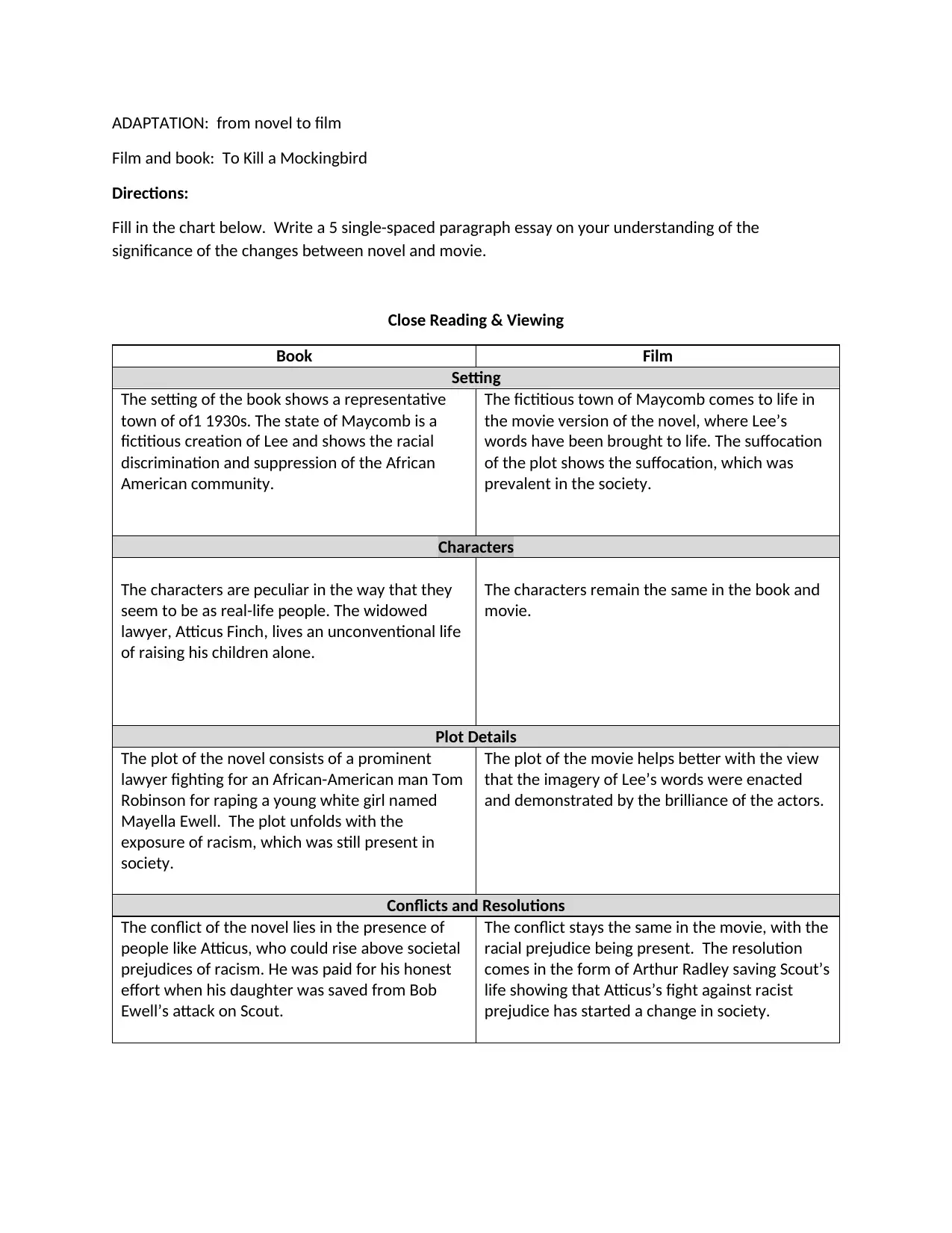
ADAPTATION: from novel to film
Film and book: To Kill a Mockingbird
Directions:
Fill in the chart below. Write a 5 single-spaced paragraph essay on your understanding of the
significance of the changes between novel and movie.
Close Reading & Viewing
Book Film
Setting
The setting of the book shows a representative
town of of1 1930s. The state of Maycomb is a
fictitious creation of Lee and shows the racial
discrimination and suppression of the African
American community.
The fictitious town of Maycomb comes to life in
the movie version of the novel, where Lee’s
words have been brought to life. The suffocation
of the plot shows the suffocation, which was
prevalent in the society.
Characters
The characters are peculiar in the way that they
seem to be as real-life people. The widowed
lawyer, Atticus Finch, lives an unconventional life
of raising his children alone.
The characters remain the same in the book and
movie.
Plot Details
The plot of the novel consists of a prominent
lawyer fighting for an African-American man Tom
Robinson for raping a young white girl named
Mayella Ewell. The plot unfolds with the
exposure of racism, which was still present in
society.
The plot of the movie helps better with the view
that the imagery of Lee’s words were enacted
and demonstrated by the brilliance of the actors.
Conflicts and Resolutions
The conflict of the novel lies in the presence of
people like Atticus, who could rise above societal
prejudices of racism. He was paid for his honest
effort when his daughter was saved from Bob
Ewell’s attack on Scout.
The conflict stays the same in the movie, with the
racial prejudice being present. The resolution
comes in the form of Arthur Radley saving Scout’s
life showing that Atticus’s fight against racist
prejudice has started a change in society.
Film and book: To Kill a Mockingbird
Directions:
Fill in the chart below. Write a 5 single-spaced paragraph essay on your understanding of the
significance of the changes between novel and movie.
Close Reading & Viewing
Book Film
Setting
The setting of the book shows a representative
town of of1 1930s. The state of Maycomb is a
fictitious creation of Lee and shows the racial
discrimination and suppression of the African
American community.
The fictitious town of Maycomb comes to life in
the movie version of the novel, where Lee’s
words have been brought to life. The suffocation
of the plot shows the suffocation, which was
prevalent in the society.
Characters
The characters are peculiar in the way that they
seem to be as real-life people. The widowed
lawyer, Atticus Finch, lives an unconventional life
of raising his children alone.
The characters remain the same in the book and
movie.
Plot Details
The plot of the novel consists of a prominent
lawyer fighting for an African-American man Tom
Robinson for raping a young white girl named
Mayella Ewell. The plot unfolds with the
exposure of racism, which was still present in
society.
The plot of the movie helps better with the view
that the imagery of Lee’s words were enacted
and demonstrated by the brilliance of the actors.
Conflicts and Resolutions
The conflict of the novel lies in the presence of
people like Atticus, who could rise above societal
prejudices of racism. He was paid for his honest
effort when his daughter was saved from Bob
Ewell’s attack on Scout.
The conflict stays the same in the movie, with the
racial prejudice being present. The resolution
comes in the form of Arthur Radley saving Scout’s
life showing that Atticus’s fight against racist
prejudice has started a change in society.
Paraphrase This Document
Need a fresh take? Get an instant paraphrase of this document with our AI Paraphraser
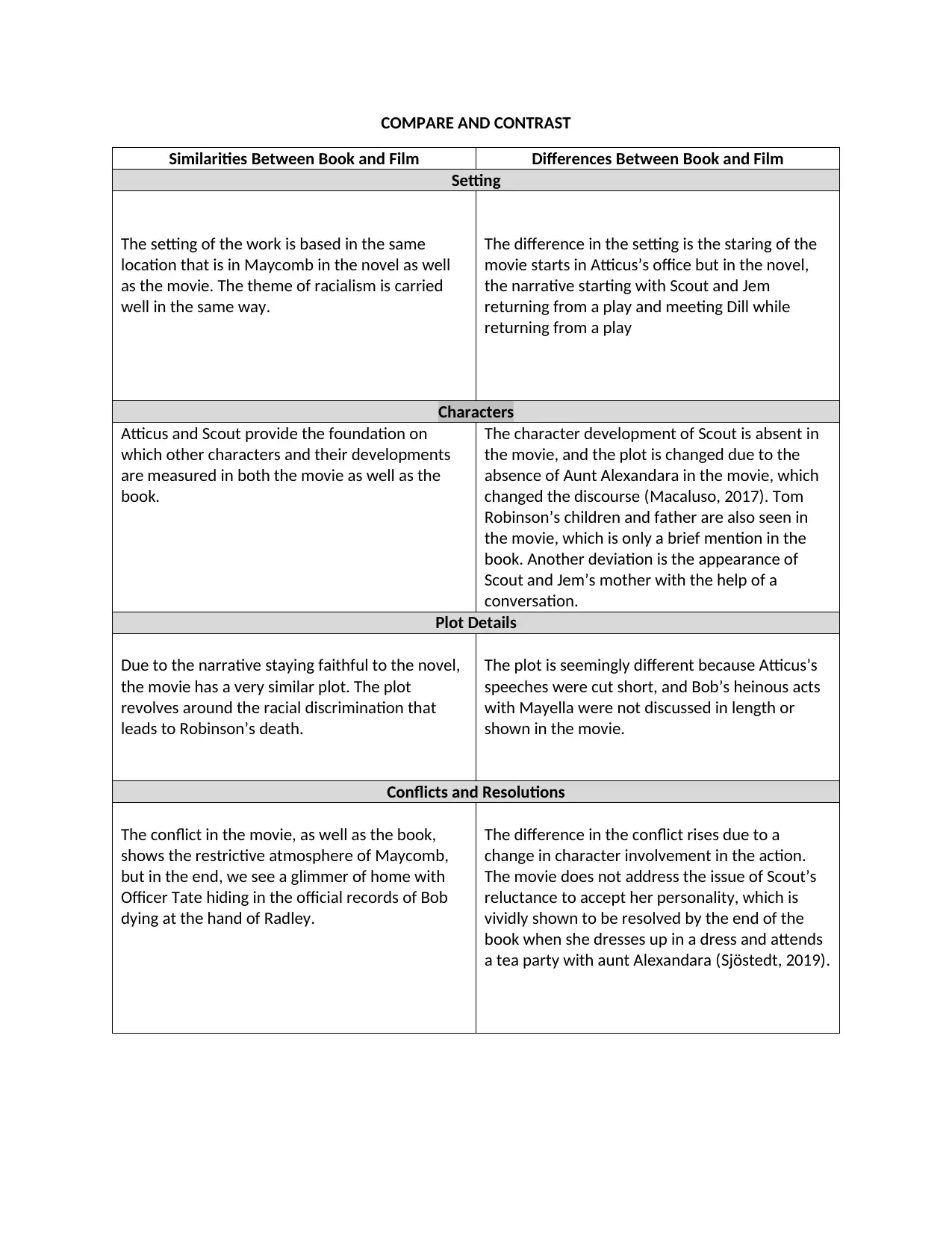
COMPARE AND CONTRAST
Similarities Between Book and Film Differences Between Book and Film
Setting
The setting of the work is based in the same
location that is in Maycomb in the novel as well
as the movie. The theme of racialism is carried
well in the same way.
The difference in the setting is the staring of the
movie starts in Atticus’s office but in the novel,
the narrative starting with Scout and Jem
returning from a play and meeting Dill while
returning from a play
Characters
Atticus and Scout provide the foundation on
which other characters and their developments
are measured in both the movie as well as the
book.
The character development of Scout is absent in
the movie, and the plot is changed due to the
absence of Aunt Alexandara in the movie, which
changed the discourse (Macaluso, 2017). Tom
Robinson’s children and father are also seen in
the movie, which is only a brief mention in the
book. Another deviation is the appearance of
Scout and Jem’s mother with the help of a
conversation.
Plot Details
Due to the narrative staying faithful to the novel,
the movie has a very similar plot. The plot
revolves around the racial discrimination that
leads to Robinson’s death.
The plot is seemingly different because Atticus’s
speeches were cut short, and Bob’s heinous acts
with Mayella were not discussed in length or
shown in the movie.
Conflicts and Resolutions
The conflict in the movie, as well as the book,
shows the restrictive atmosphere of Maycomb,
but in the end, we see a glimmer of home with
Officer Tate hiding in the official records of Bob
dying at the hand of Radley.
The difference in the conflict rises due to a
change in character involvement in the action.
The movie does not address the issue of Scout’s
reluctance to accept her personality, which is
vividly shown to be resolved by the end of the
book when she dresses up in a dress and attends
a tea party with aunt Alexandara (Sjöstedt, 2019).
Similarities Between Book and Film Differences Between Book and Film
Setting
The setting of the work is based in the same
location that is in Maycomb in the novel as well
as the movie. The theme of racialism is carried
well in the same way.
The difference in the setting is the staring of the
movie starts in Atticus’s office but in the novel,
the narrative starting with Scout and Jem
returning from a play and meeting Dill while
returning from a play
Characters
Atticus and Scout provide the foundation on
which other characters and their developments
are measured in both the movie as well as the
book.
The character development of Scout is absent in
the movie, and the plot is changed due to the
absence of Aunt Alexandara in the movie, which
changed the discourse (Macaluso, 2017). Tom
Robinson’s children and father are also seen in
the movie, which is only a brief mention in the
book. Another deviation is the appearance of
Scout and Jem’s mother with the help of a
conversation.
Plot Details
Due to the narrative staying faithful to the novel,
the movie has a very similar plot. The plot
revolves around the racial discrimination that
leads to Robinson’s death.
The plot is seemingly different because Atticus’s
speeches were cut short, and Bob’s heinous acts
with Mayella were not discussed in length or
shown in the movie.
Conflicts and Resolutions
The conflict in the movie, as well as the book,
shows the restrictive atmosphere of Maycomb,
but in the end, we see a glimmer of home with
Officer Tate hiding in the official records of Bob
dying at the hand of Radley.
The difference in the conflict rises due to a
change in character involvement in the action.
The movie does not address the issue of Scout’s
reluctance to accept her personality, which is
vividly shown to be resolved by the end of the
book when she dresses up in a dress and attends
a tea party with aunt Alexandara (Sjöstedt, 2019).
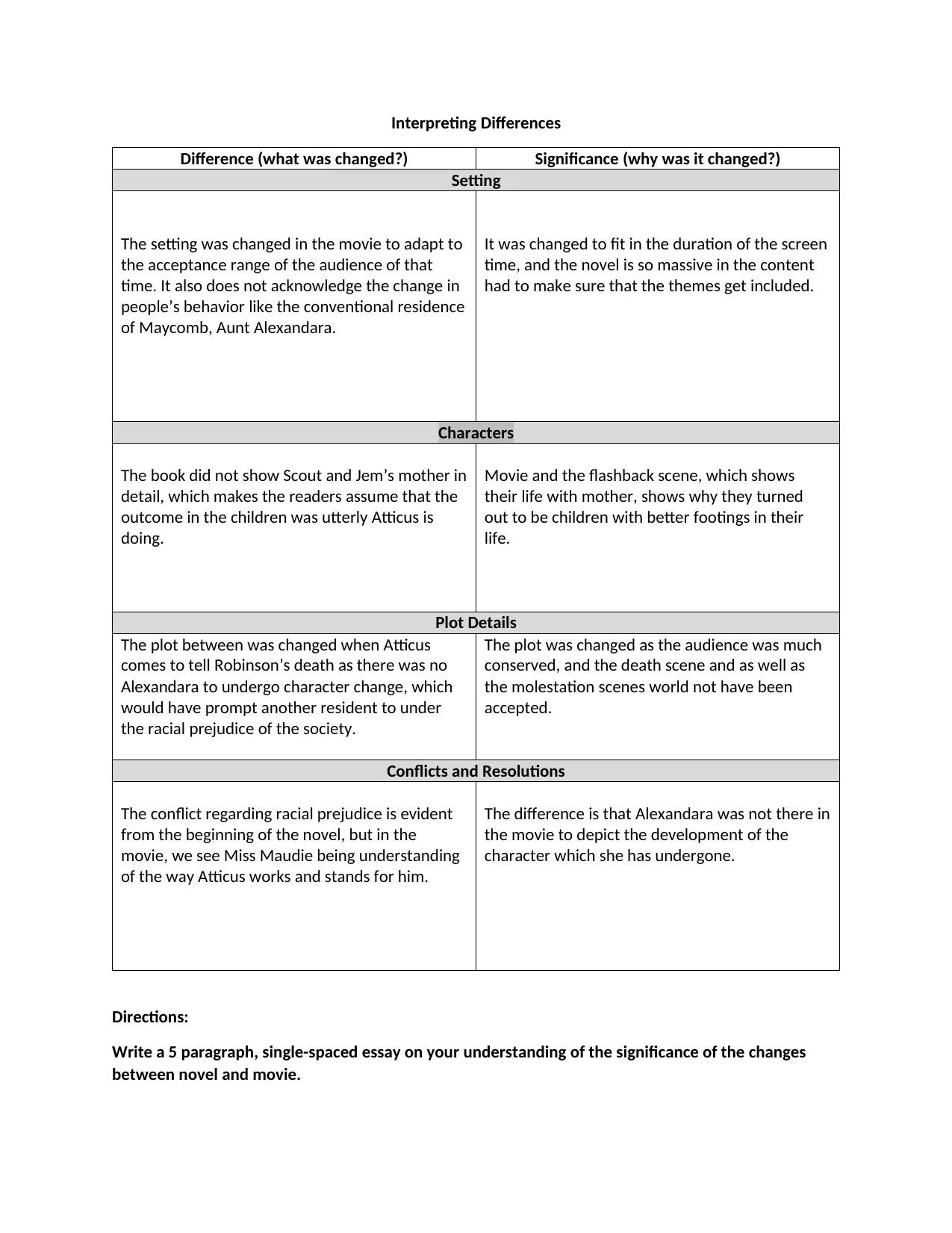
Interpreting Differences
Difference (what was changed?) Significance (why was it changed?)
Setting
The setting was changed in the movie to adapt to
the acceptance range of the audience of that
time. It also does not acknowledge the change in
people’s behavior like the conventional residence
of Maycomb, Aunt Alexandara.
It was changed to fit in the duration of the screen
time, and the novel is so massive in the content
had to make sure that the themes get included.
Characters
The book did not show Scout and Jem’s mother in
detail, which makes the readers assume that the
outcome in the children was utterly Atticus is
doing.
Movie and the flashback scene, which shows
their life with mother, shows why they turned
out to be children with better footings in their
life.
Plot Details
The plot between was changed when Atticus
comes to tell Robinson’s death as there was no
Alexandara to undergo character change, which
would have prompt another resident to under
the racial prejudice of the society.
The plot was changed as the audience was much
conserved, and the death scene and as well as
the molestation scenes world not have been
accepted.
Conflicts and Resolutions
The conflict regarding racial prejudice is evident
from the beginning of the novel, but in the
movie, we see Miss Maudie being understanding
of the way Atticus works and stands for him.
The difference is that Alexandara was not there in
the movie to depict the development of the
character which she has undergone.
Directions:
Write a 5 paragraph, single-spaced essay on your understanding of the significance of the changes
between novel and movie.
Difference (what was changed?) Significance (why was it changed?)
Setting
The setting was changed in the movie to adapt to
the acceptance range of the audience of that
time. It also does not acknowledge the change in
people’s behavior like the conventional residence
of Maycomb, Aunt Alexandara.
It was changed to fit in the duration of the screen
time, and the novel is so massive in the content
had to make sure that the themes get included.
Characters
The book did not show Scout and Jem’s mother in
detail, which makes the readers assume that the
outcome in the children was utterly Atticus is
doing.
Movie and the flashback scene, which shows
their life with mother, shows why they turned
out to be children with better footings in their
life.
Plot Details
The plot between was changed when Atticus
comes to tell Robinson’s death as there was no
Alexandara to undergo character change, which
would have prompt another resident to under
the racial prejudice of the society.
The plot was changed as the audience was much
conserved, and the death scene and as well as
the molestation scenes world not have been
accepted.
Conflicts and Resolutions
The conflict regarding racial prejudice is evident
from the beginning of the novel, but in the
movie, we see Miss Maudie being understanding
of the way Atticus works and stands for him.
The difference is that Alexandara was not there in
the movie to depict the development of the
character which she has undergone.
Directions:
Write a 5 paragraph, single-spaced essay on your understanding of the significance of the changes
between novel and movie.
⊘ This is a preview!⊘
Do you want full access?
Subscribe today to unlock all pages.

Trusted by 1+ million students worldwide
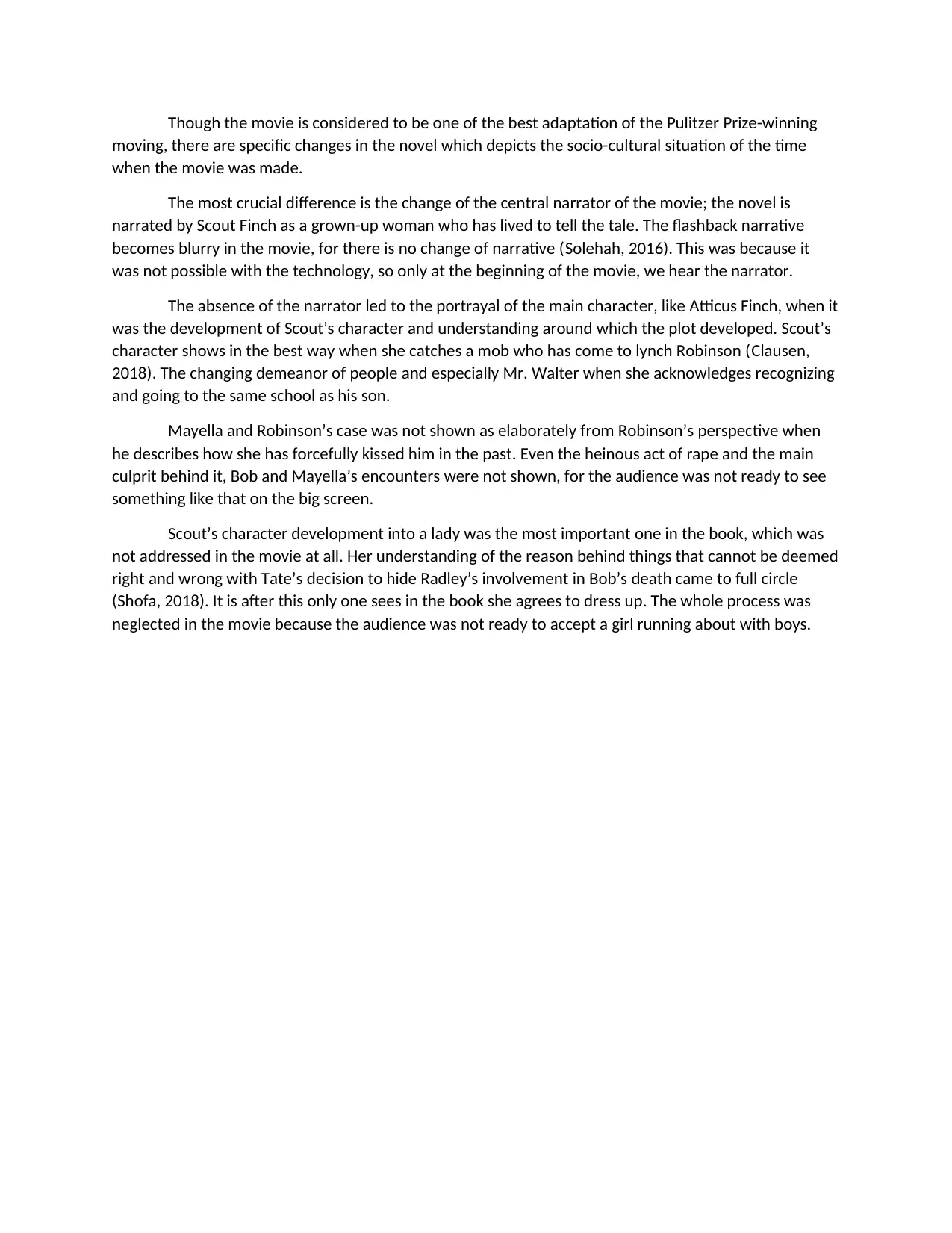
Though the movie is considered to be one of the best adaptation of the Pulitzer Prize-winning
moving, there are specific changes in the novel which depicts the socio-cultural situation of the time
when the movie was made.
The most crucial difference is the change of the central narrator of the movie; the novel is
narrated by Scout Finch as a grown-up woman who has lived to tell the tale. The flashback narrative
becomes blurry in the movie, for there is no change of narrative (Solehah, 2016). This was because it
was not possible with the technology, so only at the beginning of the movie, we hear the narrator.
The absence of the narrator led to the portrayal of the main character, like Atticus Finch, when it
was the development of Scout’s character and understanding around which the plot developed. Scout’s
character shows in the best way when she catches a mob who has come to lynch Robinson (Clausen,
2018). The changing demeanor of people and especially Mr. Walter when she acknowledges recognizing
and going to the same school as his son.
Mayella and Robinson’s case was not shown as elaborately from Robinson’s perspective when
he describes how she has forcefully kissed him in the past. Even the heinous act of rape and the main
culprit behind it, Bob and Mayella’s encounters were not shown, for the audience was not ready to see
something like that on the big screen.
Scout’s character development into a lady was the most important one in the book, which was
not addressed in the movie at all. Her understanding of the reason behind things that cannot be deemed
right and wrong with Tate’s decision to hide Radley’s involvement in Bob’s death came to full circle
(Shofa, 2018). It is after this only one sees in the book she agrees to dress up. The whole process was
neglected in the movie because the audience was not ready to accept a girl running about with boys.
moving, there are specific changes in the novel which depicts the socio-cultural situation of the time
when the movie was made.
The most crucial difference is the change of the central narrator of the movie; the novel is
narrated by Scout Finch as a grown-up woman who has lived to tell the tale. The flashback narrative
becomes blurry in the movie, for there is no change of narrative (Solehah, 2016). This was because it
was not possible with the technology, so only at the beginning of the movie, we hear the narrator.
The absence of the narrator led to the portrayal of the main character, like Atticus Finch, when it
was the development of Scout’s character and understanding around which the plot developed. Scout’s
character shows in the best way when she catches a mob who has come to lynch Robinson (Clausen,
2018). The changing demeanor of people and especially Mr. Walter when she acknowledges recognizing
and going to the same school as his son.
Mayella and Robinson’s case was not shown as elaborately from Robinson’s perspective when
he describes how she has forcefully kissed him in the past. Even the heinous act of rape and the main
culprit behind it, Bob and Mayella’s encounters were not shown, for the audience was not ready to see
something like that on the big screen.
Scout’s character development into a lady was the most important one in the book, which was
not addressed in the movie at all. Her understanding of the reason behind things that cannot be deemed
right and wrong with Tate’s decision to hide Radley’s involvement in Bob’s death came to full circle
(Shofa, 2018). It is after this only one sees in the book she agrees to dress up. The whole process was
neglected in the movie because the audience was not ready to accept a girl running about with boys.
Paraphrase This Document
Need a fresh take? Get an instant paraphrase of this document with our AI Paraphraser
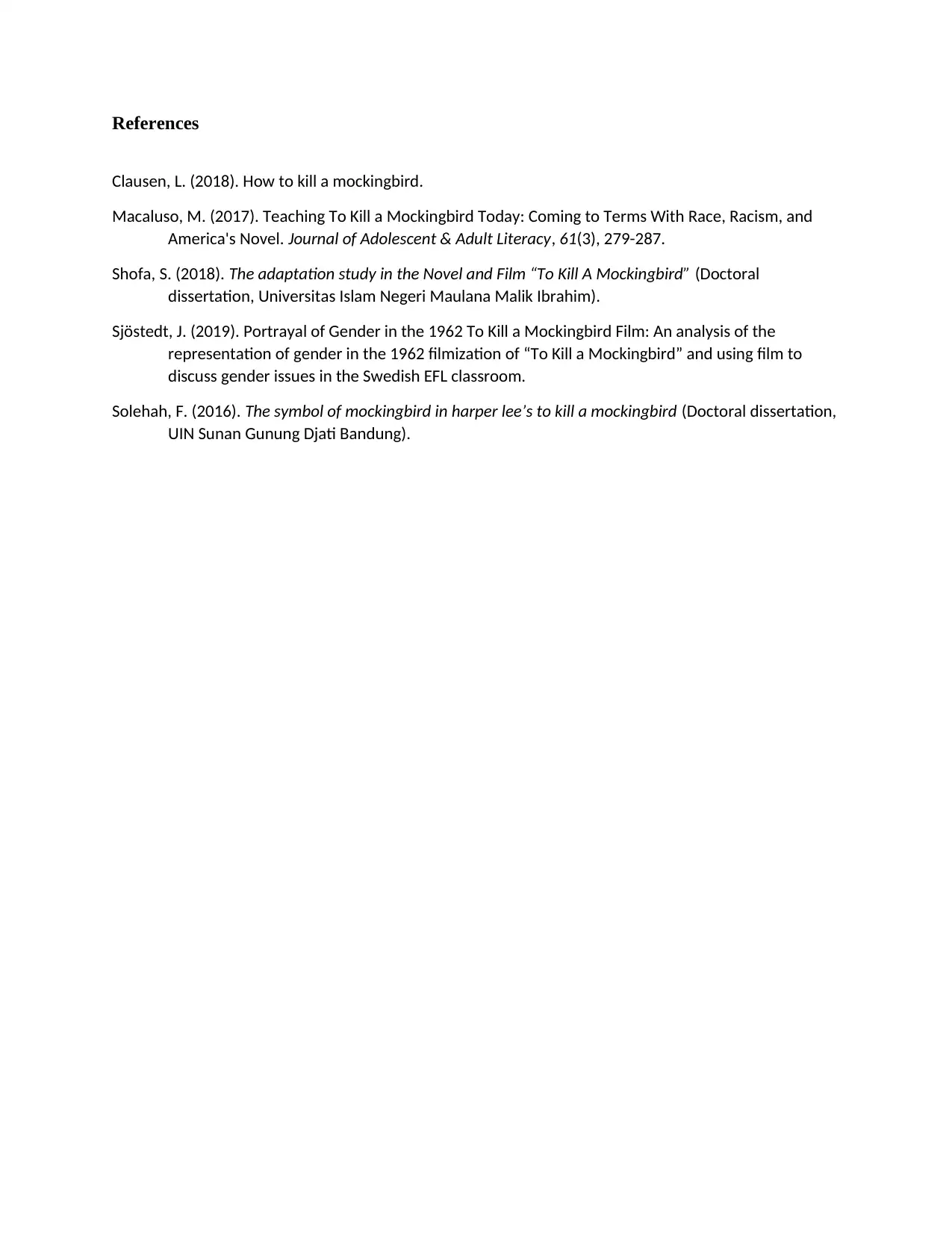
References
Clausen, L. (2018). How to kill a mockingbird.
Macaluso, M. (2017). Teaching To Kill a Mockingbird Today: Coming to Terms With Race, Racism, and
America's Novel. Journal of Adolescent & Adult Literacy, 61(3), 279-287.
Shofa, S. (2018). The adaptation study in the Novel and Film “To Kill A Mockingbird” (Doctoral
dissertation, Universitas Islam Negeri Maulana Malik Ibrahim).
Sjöstedt, J. (2019). Portrayal of Gender in the 1962 To Kill a Mockingbird Film: An analysis of the
representation of gender in the 1962 filmization of “To Kill a Mockingbird” and using film to
discuss gender issues in the Swedish EFL classroom.
Solehah, F. (2016). The symbol of mockingbird in harper lee’s to kill a mockingbird (Doctoral dissertation,
UIN Sunan Gunung Djati Bandung).
Clausen, L. (2018). How to kill a mockingbird.
Macaluso, M. (2017). Teaching To Kill a Mockingbird Today: Coming to Terms With Race, Racism, and
America's Novel. Journal of Adolescent & Adult Literacy, 61(3), 279-287.
Shofa, S. (2018). The adaptation study in the Novel and Film “To Kill A Mockingbird” (Doctoral
dissertation, Universitas Islam Negeri Maulana Malik Ibrahim).
Sjöstedt, J. (2019). Portrayal of Gender in the 1962 To Kill a Mockingbird Film: An analysis of the
representation of gender in the 1962 filmization of “To Kill a Mockingbird” and using film to
discuss gender issues in the Swedish EFL classroom.
Solehah, F. (2016). The symbol of mockingbird in harper lee’s to kill a mockingbird (Doctoral dissertation,
UIN Sunan Gunung Djati Bandung).
1 out of 5
Related Documents
Your All-in-One AI-Powered Toolkit for Academic Success.
+13062052269
info@desklib.com
Available 24*7 on WhatsApp / Email
![[object Object]](/_next/static/media/star-bottom.7253800d.svg)
Unlock your academic potential
Copyright © 2020–2025 A2Z Services. All Rights Reserved. Developed and managed by ZUCOL.





